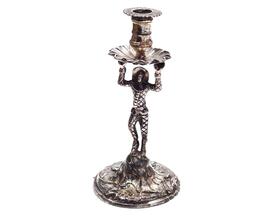Broadening Appreciation for a Taperstick
Broadening Appreciation for a Taperstick
By Elizabeth Talbot
TW Gaze’s next dedicated Silver Sale, to be held at Diss Auction Rooms on 21 April, contains, amongst other items, over 100 lots from an intriguing Norfolk single-owner collection; and from this consignment, one specific piece stands out as worthy of some attention: an 18th Century figural taperstick by John Cafe.
A taperstick is like a candlestick in terms of form but is smaller in scale and is used to hold a taper (a very thin candle). The socket sometimes needed to be lined with paper so as to hold the tall thin taper securely in place. The wax taper was used mainly for melting sealing wax and for lighting candles, tobacco pipes etc., not as a source of illumination, so it was not unusual for them to be created as single pieces and not in pairs, because one was usually sufficient for such purposes.
This little stick is all the more distinctive because the stem is in the form of Arlecchino, or Harlequin, who, along with Pulcinella, was one of the principal stock characters of a popular Italian theatrical form that flourished throughout Europe from the 16th Century right through the 18th Century. Outside Italy commedia dell’arte (“comedy of the profession”) was most popular in France, where it became Comédie-Italienne; but a similar tradition was introduced into England by Italian puppeteers who arrived after the restoration of Charles II in 1660. Two years later, the first references to Punchinello appeared in the writings of diarist Samuel Pepys and it was soon shortened to Punch. The tradition of Punch and Judy shows as we might recognize them began as early as 1700, and the figure of Mr Punch became a very familiar character. Equally, parallel elements of this artistry found their way into our nation’s pantomime tradition, along with Harlequin, the principal character of the slapstick pantomime form known as harlequinade.
In the early years of the commedia Harlequin was a wily and covetous comic servant; cowardly, superstitious, and plagued by a continual lack of money and food. However, by the early 17th Century, Harlequin had become a faithful valet, patient, credulous, and amorous. His costume was originally a peasant’s shirt and long trousers, both covered with many coloured patches. It later developed into a tight-fitting costume decorated with triangles and diamond shapes. His black half mask had tiny eyeholes and quizzically arched eyebrows that were accentuated by a wrinkled forehead. He was a popular character, a lovable rogue and visually distinctive.
Combining all these factors he made the perfect subject for a fashionable novelty in the form of an expensive piece of silver to be displayed by members of the wealthy, culture-conscious members of 18th Century society.
So, to the man who made this taperstick. Under the base it bears the initials “JC” surmounted by a Tudor rose within a trefoil, the distinctive hall mark of John Cafe. Details of Cafe’s life are scarce and even his name is in doubt; it may be Cafe, Café or even Case. It is thought he began producing silver around 1740 and he is known to have specialized in making candlesticks, and particularly figural ones. It is also known that he died in 1757 at which point the business was passed to his brother, William Cafe, who had previously been his apprentice; in which case, years of production are relatively modest in number, so potentially adding to the scarcity of his works.
Cafe’s sticks are distinctive because he makes them by casting the silver. Cast figural candlesticks were made in Europe in the Gothic Period, but usually in brass alloy. The creation of cast candlesticks in silver in Britain was a consequence of the creation of the Britannia Standard. Parliament passed an act in 1697 requiring the standard of silver to be changed from Sterling at 925 parts per thousand, to the Britannia standard at 950 parts silver per thousand. The Britannia standard remained mandatory until 1720, when it became optional.
The new metal of the Britannia standard was softer than the previous Sterling standard. Until the creation of the new standard, sterling candlesticks and other silver objects had often been hammered, but the softer metal did not lend itself to this treatment, so new techniques for the casting of silver were developed. John Cafe used the learned methods to cast in sterling silver, using the techniques developed in the Britannia period. His candlesticks and tapersticks tend to be thickly cast and heavy relative to size: the example for sale in Diss is 13.5cm tall and weighs 169g.
The taperstick carries a pre-auction estimate of £800 – 1,200 and will be a fine addition to a serious collection.

